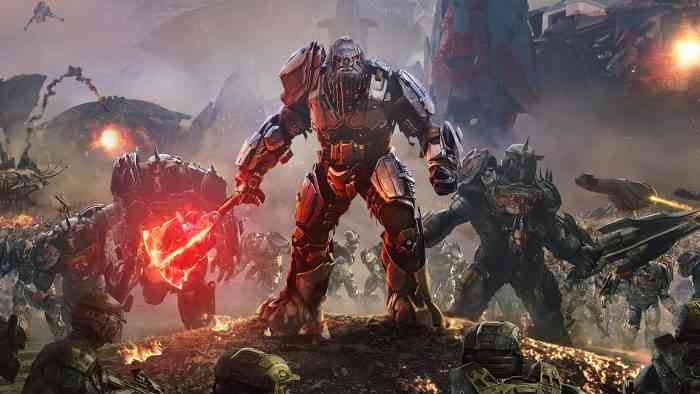Halo Wars 2 Q&A
Recently, COGconnected was offered an opportunity to further explore the partnership between 343 Industries and Creative Assembly for Halo Wars 2 in an exclusive Q&A interview. It is certainly one the more interesting collaborations in the industry, so we gladly accepted as we wanted to dive deeper into this relationship. As a result, we interviewed Dan Ayoub, Studio Head of Strategy Games at 343 Industries, and David Nicholson, Executive Producer at Creative Assembly to get their thoughts on not only the game but the journey leading up to release day.

343 Industries has said they had to wait for the right partner. Aside from their reputation, why did 343 choose Creative Assembly? Was there something specific or a certain skill set 343 was looking for?
David: We decided to partner with each other on “Halo Wars 2” because we both have a huge love of RTS as a genre and Halo as a universe and wanted to encourage more people to experience both. Together we knew we could bring something new and exciting to the genre to satisfy both RTS fans and Halo fans. Obviously Creative Assembly have a strong heritage in making very high quality RTS games over many years and it is that pedigree that meant 343 Industries were confident that the wonderful universe that is Halo would be treated to some of the very best RTS development talent available.
With both 343 Industries and Creative Assembly being highly successful game development companies, how did the partnership evolve and what has the dynamic been like? At what point did the teams realize it was a perfect match?
Dan: I believe we knew it was a match at the first meeting we had together. I say all the time that I could immediately feel the chemistry between the two teams, and that has continued throughout the course of development. I can’t say enough great things about the dynamic – I get asked a lot about how things worked, and we really functioned as a single team: The “Halo Wars 2” team, and that made all the difference.
During the development process did one development team take charge of certain aspects or was everything worked on in conjunction?
David: It’s fair to say that we were always aiming for the same thing, the same feelings and emotions from the players, the same accessibility for new players and the same depth for RTS fans, so it always felt like we were “one team” with a shared goal, working on everything in conjunction.
With advances in technology, working together remotely has never been easier. However, it likely presented some challenges. What kind of difficulties or challenges did you encounter during the development process with one team being from the UK and the other from America? Did development situations call for an in-person meeting?
Dan: The biggest things we hit were time differences, and having to do most communication by phone. The teams talked every day, and we did a number of in-person trips over the course of the development cycle, which really helped to push things forward. Really, once the teams had that mutual trust, it started to feel like an advantage more than a hindrance, because someone was working almost all the time.
Creative Assembly’s RTS pedigree is world-renowned, what kind of challenges did they face when applying their knowledge and expertise to the Halo universe?
David: Our motivation came from the desire to tell a great Halo story and make a great Halo game through a genre that we all know and love while also bringing new people into both the story and the genre. Bringing the innovative new mode that is Blitz to the players was a very exciting journey through many prototypes and experiments to ensure it had both the accessibility we wanted and the depth it deserved.
With a lot of experience between the two developers, what were the biggest takeaways resulting from the collaborative effort?
Dan: Here you had two very experienced teams, and I was amazed to see how well it worked. There were no egos, and we were united by our ambitions on the game. I think the biggest product of this partnership was Blitz; I truly believe that mode could not have existed had either group tried to tackle it alone, it was a beautiful product of teams with different backgrounds coming together to try something different.
With Halo Wars 2 postured to be a well received title based on the Beta impressions, are we likely to see another collaborative effort between the two developers?
Dan: We’re certainly hopeful that the fans love the game as we poured an incredible amount of energy and passion into it. I’m excited to see what we can do next together; I saw a lot that once a team has shipped together, it really gels and their ability levels up – I think we can look forward to some amazing things.
It has been said the team aims to introduce new players to the strategy game genre while appeasing experienced players. How does Halo Wars 2 accomplish that?
David: We’re really pleased to have been able to deliver a game that can be called “the RTS for everyone.”
We have modes like Deathmatch, that appeals to a more traditional RTS player who wants to balance production queues, build orders, resources & supplies, map control etc., through Domination and Strongholds modes where the game looks after some of those aspects for you and means you have fewer “plates to spin” right across to the new Blitz mode where you deploy your units directly from your card-deck in a fast paced, accessible yet deep battle.
We have seen that, whichever background they are from, as existing RTS fans or as newcomers to the genre, players are finding “Halo Wars 2” to be a great story and a really compelling game.